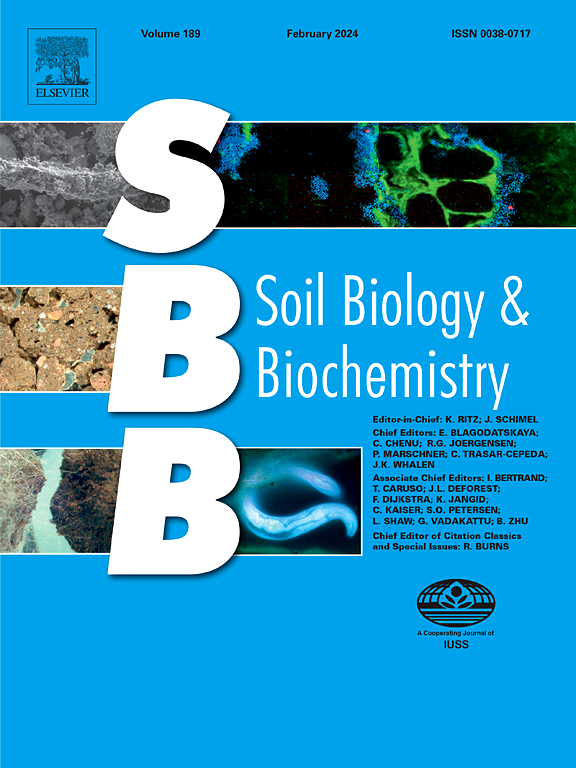Diverging soil peroxidase activity under ectomycorrhizal versus arbuscular mycorrhizal conifers with increasing C:N and exchangeable manganese
IF 10.3
1区 农林科学
Q1 SOIL SCIENCE
引用次数: 0
Abstract
Ectomycorrhizal (EM) fungi purportedly contribute to the enzymatic decay of soil organic matter (SOM), in contrast to arbuscular mycorrhizal (AM) stands where SOM turnover may be more fully governed by free-living saprotrophic fungi. We tested this distinction in a 30-year-old mixedwood conifer trial by comparing total peroxidase activity (including manganese-peroxidase [MnP]), fungal communities and mass of the humus layer between Pseudotsuga menziesii (EM host), Thuja plicata (AM host), and a 50:50 mixture across a natural productivity gradient. Total peroxidase and MnP activity diverged between hosts as humus C:N ratio increased, culminating in 3- to 4-fold greater enzyme activity under P. menziesii on low fertility soils. This soil effect also correlated positively with exchangeable Mn, highlighting a possible further restriction on SOM turnover under EM stands. Peroxidase activity was well aligned with a subset of abundant EM fungal species, notably Piloderma olivaceum and Piloderma sphaerosporum, suggesting a much greater enzymatic contribution by these symbiotic fungi in comparison to saprotrophic fungi under T. plicata. After three decades, mass of the humus layer averaged 2.15 kg OM m−2 and did not yet differ among stand types. However, a 3-fold range in humus mass in correlation with declining soil fertility under P. menziesii suggests that select EM fungal taxa engaged in organic N liberation can limit SOM accumulation. This research highlights the adaptive ligninolytic enzymatic capacity of EM fungal communities and underscores how dual soil properties (low N or high Mn availability) may enhance peroxidase production and SOM turnover in EM forests.
外生菌根针叶树与丛枝菌根针叶树土壤过氧化物酶活性随碳氮和交换态锰的增加而分化
外生菌根(EM)真菌据称有助于土壤有机质(SOM)的酶促衰变,与丛枝菌根(AM)相比,SOM的周转可能更完全由自由生活的腐养真菌控制。我们在一个30年的混交木针叶树试验中,通过比较menziesii (EM寄主)、plicata (AM寄主)和50:50混合物在自然生产力梯度上的总过氧化物酶活性(包括锰-过氧化物酶[MnP])、真菌群落和腐殖质层质量来检验这种区别。随着腐殖质碳氮比的增加,总过氧化物酶和MnP活性在不同寄主之间存在差异,在低肥力土壤上,门齐螺旋藻的酶活性提高了3 ~ 4倍。这种土壤效应也与可交换Mn呈正相关,表明EM林下SOM周转可能受到进一步限制。过氧化物酶活性与丰富的EM真菌物种,特别是橄榄皮霉(Piloderma olivacium)和球孢皮霉(pilderma sphaerosporum)的一个亚群很好地一致,表明与T. plicata下的腐养真菌相比,这些共生真菌对酶的贡献要大得多。30年后,腐殖质层质量平均为2.15 kg m-2,林分类型间尚无差异。然而,门氏霉腐殖质质量与土壤肥力下降相关的3倍范围表明,选择参与有机氮释放的EM真菌类群可以限制SOM的积累。这项研究强调了EM真菌群落的适应性木质素分解酶能力,并强调了双重土壤特性(低N或高Mn有效性)如何提高EM森林中过氧化物酶的产生和SOM的周转量。
本文章由计算机程序翻译,如有差异,请以英文原文为准。
求助全文
约1分钟内获得全文
求助全文
来源期刊

Soil Biology & Biochemistry
农林科学-土壤科学
CiteScore
16.90
自引率
9.30%
发文量
312
审稿时长
49 days
期刊介绍:
Soil Biology & Biochemistry publishes original research articles of international significance focusing on biological processes in soil and their applications to soil and environmental quality. Major topics include the ecology and biochemical processes of soil organisms, their effects on the environment, and interactions with plants. The journal also welcomes state-of-the-art reviews and discussions on contemporary research in soil biology and biochemistry.
 求助内容:
求助内容: 应助结果提醒方式:
应助结果提醒方式:


